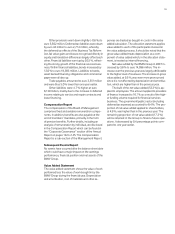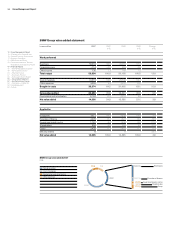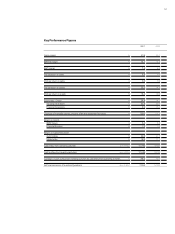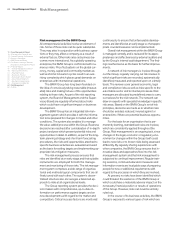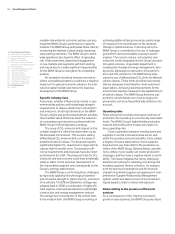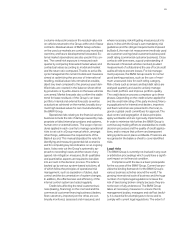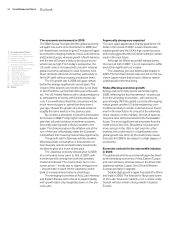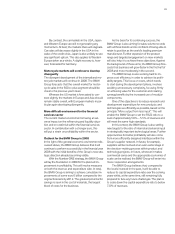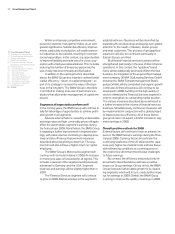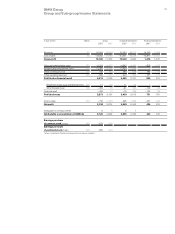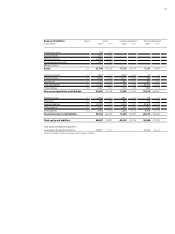BMW 2007 Annual Report Download - page 67
Download and view the complete annual report
Please find page 67 of the 2007 BMW annual report below. You can navigate through the pages in the report by either clicking on the pages listed below, or by using the keyword search tool below to find specific information within the annual report.65
a volume-induced increase in the residual value risk
on vehicles returned to the Group at the end of lease
contracts. Residual values of BMW Group vehicles
on the used car markets are continuously monitored
over time, and future developments forecasted. Ex-
ternal market observations are also used in this con-
text. The overall risk exposure is measured each
quarter by comparing forecasted market values and
contractual values according to model and market
and the return ratio computed. Thanks to active life-
cycle management for current models and measures
aimed at optimising the process of international
reselling, residual value risks remained at a stable,
albeit low, level compared to the previous year. Iden-
tified risks are covered in the balance sheet either
by provisions or by write-downs on the lease vehicles
concerned. Market forecasts also confirm the stable
trend for lease residuals of the Group’s car lease
portfolio. Internal and external forecasts as well as
actual prices achieved on the market, broadly docu-
ment high residual values for cars manufactured by
the BMW Group.
Operational risks relating to the financial services
business include the risk of damage caused by inap-
propriate or failed internal procedures and systems,
human error or external factors. The scope of proce-
dures applied in each country to manage operational
risks is set out in a Group manual which, amongst
other things, addresses the requirements of the
Basle II accord. This manual stipulates the rules for
identifying and measuring potential risk scenarios
and for computing key risk indicators on an ongoing
basis. It also sets out the Group’s systematic ap-
proach to recording losses and the nature of any
agreed risk mitigation measures. Both qualitative
and quantitative aspects are required to be taken
into account in the decision process. The latter is
backed up by various system-based solutions, all
of which follow the principles of operational risk
manage ment, such as separation of duties, dual
control and the documentation of system changes.
In addition, the effectiveness and efficiency of the
internal control system are tested regularly.
Credit risks affecting the retail customer busi-
ness (leasing, financing) on the one hand and the
commercial customer financing business (dealers,
fleet customers, importers) on the other, are con-
tinually monitored, assessed and measured, and
where necessary, risk mitigating measures put into
place. In line with the Group’s own mandatory risk
guidelines and the stringent requirements imposed
by Basle II, the main risk measurement methods used
are customer scoring (retail customer business) and
credit rating (commercial customer business). Close
contacts with borrowers, a good understanding of
the leased or financed vehicles involved, prudent
measurement of collateral and the use of local credit
audits all help to prevent losses. For risk manage-
ment purposes, the BMW Group reverts to normal
good banking practises, such as the use of maxi-
mum unsecured risks for each rating category.
Risk criteria such as arrears and bad debt ratios are
analysed quarterly and used to actively manage
the credit portfolio and improve portfolio quality.
The credit decision process comprises up to three
phases. Depending on the credit volume applied for
and the credit risk rating of the party involved, financ-
ing applications for international dealers, importers
and fleet customers are presented to the local, re-
gional or global credit committees for approval. The
dual control and segregation of duties principles
apply worldwide and are rigorously implemented.
In order to minimise risk further, the BMW Group is
continuously making efforts to standardise its credit-
decision processes and the quality of credit applica-
tions, and to ensure that uniform and transparent
rating systems are in place worldwide. Provisions are
recognised in the balance sheet to cover identified
risks.
Legal risks
The BMW Group is currently not involved in any court
or arbitration proceedings which could have a signifi-
cant impact on its financial condition.
Compliance with the law is a basic prerequisite
for the success of the BMW Group. Current law pro-
vides the binding framework for the BMW Group’s
various business activities around the world. The
growing international scale of business and the huge
number of complex legal regulations increase the
risk of laws being broken simply because they are
not known or fully understood. The BMW Group
takes all necessary measures to ensure that its
management bodies, managers and staff act lawful-
ly. It is essential for all employees to know and to
comply with current legal regulations. The extent of


